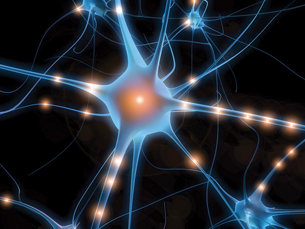Module 1
1. Module 1
1.45. Lesson 7
Module 1—The Nervous System
Lesson 7—the Nerve Impulse—Transporting the Message
 Get Focused
Get Focused

© Ricardo Verde Costa/shutterstock

© Sebastian Kaulitzki/shutterstock
Your cellphone is ringing—how did you know? At this point in the unit, you should be aware that the retina in your eye and the cochlea in your ear are detecting the flashing light and the ringing noise.
You have learned that the sense organs are responsible for detecting changes in the environment and communicating this information to the brain. You now know that the neuron facilitates communication through sensory pathways that connect sensory receptors to the lobes of the brain. Interneurons and motor neurons also play a role in processing information and communicating information to the effectors.
In this lesson you will explore how this special type of cell, the neuron, which makes up the pathways and structures of the nervous system, communicates messages through its cell structure.
You will also examine how communication is interrupted by diseases, such as multiple sclerosis and Alzheimer’s disease. This lesson is a significant opportunity for you to explore the nerve impulse as a source of communication interruption in Alzheimer’s disease as you continue work on your Module Assessment.
In this lesson you will investigate the following focusing question:
- How does the structure of a neuron facilitate reception and transmission of a nerve impulse to the synaptic gap?
Lessons 7 and 8 present concepts that are both interesting and challenging. The suggested readings will help familiarize you with the lesson content and support your lesson and Module Assessment work.
 Module 1: Lesson 7 Assignment
Module 1: Lesson 7 Assignment
Your teacher-marked Module 1: Lesson 7 Assignment requires that you complete and submit the following:
- Part 1—Action Potential OR Part 2—Action Potential
- Part 3—Reflect and Connect
Download a copy of the Module 1: Lesson 7 Assignment to your computer now. You will receive further instructions about how to complete this assignment and when to submit your work for assessment later in the lesson.
You must decide what to do with the questions that are not marked by the teacher.
Remember that these questions provide you with the practice and feedback that you need to successfully complete this course. You should respond to all the questions and place those answers in your course folder.
In addition to the lesson work that you store in your course folder, you will complete three types of questions in the Lesson 7 Assignment. In the first part of the assignment, you will analyze a graph of action potential and apply your understanding to a series of questions based on the principles illustrated in the graph. In the second part you will design a flow chart summarizing the events of the action potential. The third part of the assignment is a question similar to the closed-response written question on Diploma Exams. In this question you will apply your understanding of the principles that you have learned in this lesson to analyzing data given in the question. You will then answer a series of questions based on the data.
You will continue to add all lesson work and reflections to your course folder for later review. In addition to the assignments given in the lesson, there are several questions on page 384 and pages 402 and 403 in your textbook that you may choose to do to practise your skills when you have completed this lesson. These questions provide you with the practice and feedback that you need to successfully complete this lesson. Your teacher can give you feedback on your responses to these questions. More questions are available in The Key, the publication of Diploma Exam-style questions available from the Learning Resources Centre (LRC) or your local bookstore.
You will continue to work on your Module Assessment throughout this lesson. You will want to focus particularly on communication involving the brain and how transmission of the message in neurons of the brain can be interrupted.